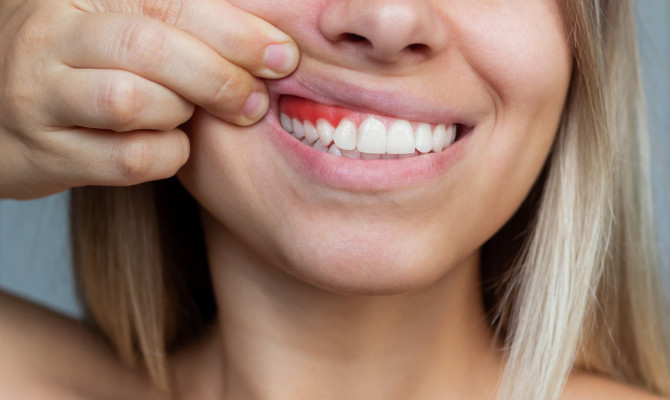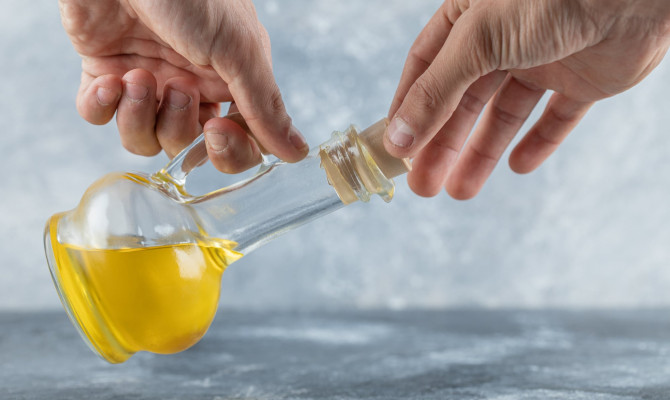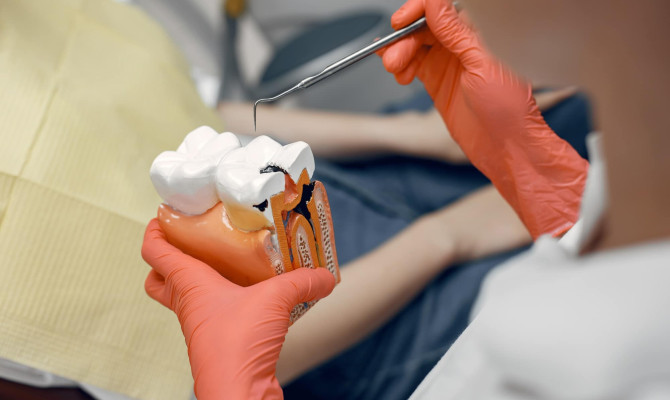All about dental extraction

- Extraction
- 16 Aug 2023
Overview
What is dental extraction?
Dental extractions, commonly called tooth extractions, entail taking teeth out of the mouth.
The patient is awake, but the region surrounding the tooth is numb when this procedure is often performed under local anesthesia.
We shall learn more about the need for a tooth pulled, problems, and care in this article.1Overview| Researched based study from Nlm.nih.gov

Indication
Who needs to get their teeth extracted?
Dental decay
- It may be required to remove a tooth when decay has caused damage that cannot be treated with fillings, crowns, or other therapeutic procedures to prevent the infection from spreading or adjacent teeth from becoming infected.
Gum disease
- Teeth with advanced gum disease may become loose or move out of place, making it harder to keep them clean and more susceptible to decay. Extraction could be required in these circumstances to prevent additional harm to the adjacent teeth and gums.
Injury or trauma
- If a tooth is fractured, shattered, or otherwise damaged due to trauma or injury and cannot be fixed or is causing pain or suffering, it may need to be extracted.2Indication| Researched based study from Nlm.nih.gov
Overcrowding
- It could be essential to remove one or more teeth if the teeth are overcrowded to provide space for orthodontic treatment or to avert future dental issues.
Impacted wisdom teeth
- Third molars, or wisdom teeth, frequently get impacted or partly erupt, resulting in discomfort, infection, or harm to the neighboring teeth. Extraction may be required in certain circumstances to alleviate pain and avoid problems.2Indication| Researched based study from Nlm.nih.gov
Types
Types of dental extraction?
Simple extractions
- They are typically carried out on teeth that are accessible early by the dentist or oral surgeon and are visible in the mouth.
- The tooth will first be made loose by the dentist using an elevator before being extracted with forceps. Patients often feel little to no pain during the treatment, typically under local anesthesia.
Surgical extractions
- They are more complex than simple ones and are frequently carried out on teeth that are broken, impacted, or difficult for the dentist to access. An incision will be created in the gum tissue to allow access to the tooth and maybe some bone in order to properly extract the tooth. Although local anesthesia is frequently used, sedation may also be used to make patients more comfortable during the procedure.1Types| Researched based study from Nlm.nih.gov
In addition to these, there are further types, including as:
Extraction of the wisdom teeth
- They are the third set of molars frequently needing extraction due to impaction. They could be simple or surgical, depending on where the teeth are and how well they’re doing.
Extractions for orthodontics
- In rare circumstances, a patient could require tooth extractions to make place for braces therapy. These are usually quick and easy and are done before the treatment starts.1Types| Researched based study from Nlm.nih.gov
Pre-procedure
Preparing for the dental extraction procedure
To guarantee a successful and easy process, this stage is crucial. The following are some preparations you might want to make:4Pre-procedure| Researched based study from Nhs.uk
Consultation
- The first step is to consult your dentist to review your medical background and any medications you are currently taking. The best course of action will be decided after several oral tests.
Examination and testing before extraction
- To assess the state of the tooth and its supporting components, your dentist might occasionally need to take X-rays or other diagnostic procedures.
Pre-procedure medications to avoid
- To reduce the chance of bleeding, your dentist might urge you to stop taking some drugs, including aspirin or blood thinners, a few days before the treatment.
Pre-extraction instructions
- Before the extraction, your dentist might give you detailed instructions to follow. These include planning transportation to and from the clinic, going without food for a predetermined period before the procedure, and dressing comfortably on the day of the procedure.
Anesthesia
- The most frequent way to extractions is under local anesthesia around the tooth; however, conscious sedation may be required when a patient has other medical issues or is anxious about having dental surgery.4Pre-procedure| Researched based study from Nhs.uk
Precautions
Precautions to take before planning an extraction
Disorders of bleeding
- Your dentist may need to take extra measures or postpone the procedure if you have a bleeding problem, like hemophilia, to reduce the risk of bleeding.
Infections
- To reduce the chance of problems, your dentist might need to treat any active infections you have before conducting the surgery, such as an abscess or gum disease.
Specific medicines
- The risk of bleeding during and after surgery may be increased by a number of drugs, including blood thinners. Before the surgery, you might be told to stop taking these medications or change the dosage temporarily.2Precaution| Researched based study from Nlm.nih.gov
Healthcare issues
- People with certain medical conditions, such as heart disease, diabetes, or high blood pressure, may require additional safety precautions or monitoring during the procedure.
Pregnancy
- Pregnant women may need to postpone non-essential dental treatments, such as extractions, to reduce the risk of difficulties until after birth.2Precaution| Researched based study from Nlm.nih.gov
Post-extraction
Post-operative care
The operated area has to be taken care of to avoid infection and promote healing after tooth extraction. Here are a few tips:
- To stop bleeding, gently bite down on a gauze pad that has been put over the wound. Replace the gauze as needed, but avoid doing so too frequently, as this might interfere with the clot’s formation.
- To avoid accidentally burning yourself, avoid consuming anything hot until the anesthesia has gone off.
- Avoid using your affected side to chew food for the first 24 hours.
- As recommended, use any prescription medication to help you manage any discomfort. Ibuprofen or paracetamol, two over-the-counter medications, could be helpful, but talk to your dentist first.
- To minimize swelling, use an ice pack on your cheek for 10 to 20 minutes.
- To help keep the wound clean and promote healing, gently rinse your mouth after 24 hours with warm salt water (one teaspoon of salt in a cup of warm water). As mouthwash might be too harsh for the area, avoid using it.3Post-extraction| Researched based study from England.nhs.uk
- Avoid smoking and using tobacco products since these habits can hamper healing and increase the likelihood of issues.
- After the extraction, stick to soft meals for a few days before resuming more challenging foods while the site recovers.
- Please pay attention to additional instructions, such as when to make a follow-up visit and when it’s okay to resume regular activities.
- Please pay attention to any further instructions your dentist may give you, such as when to arrange a follow-up appointment and when it is okay to return to your routine.3Post-extraction| Researched based study from England.nhs.uk
Complications
What are the complications?
Pain and swelling
- Although some pain and swelling are common after treatment, these symptoms should disappear in a few days. While over-the-counter painkillers can help manage the discomfort, you should see your dentist if it is severe or persists for more than a few days.
Bleeding
- Bleeding is common after tooth extraction, but excessive bleeding might be a sign of something wrong. If the bleeding continues despite applying pressure to the area for 30 minutes, talk to your dentist.
Infection
- It may happen if the area needs to be kept clean or if bacteria are introduced. Fever, edema, and pus or discharge from the extraction site are indications of infection.5Complications| Researched based study from Nlm.nih.gov
A dry socket
- The blood clot that formed at the location became dislodged, exposing the bone and nerves. This can cause infection and be extremely painful. To treat it, your dentist may recommend medication.5Complications| Researched based study from Nlm.nih.gov
Jaw fracture
- Rarely, the jaw may fracture while being treated, significantly if the tooth is impacted or the jaw is weak from osteoporosis or another condition.
Damage to adjacent teeth
- Occasionally, adjacent teeth may sustain damage. This could happen if the extraction is incredibly challenging or adjacent teeth are weak or decaying.5Complications| Researched based study from Nlm.nih.gov
Recovery
What is the recovery time?
First 24 hours
- You might experience some bleeding and swelling following the procedure, so it’s crucial to rest and refrain from strenuous activity. It would also be better to avoid using a straw when drinking and eating.
The first week
- After several days, the swelling should start to go down.
The second week
- During the second week, the pain and swelling should continue diminishing, and you can return to your regular activities.
Three to four weeks
- Even though it could take longer, the extraction site should be healed mainly by three to four weeks.1Recovery| Researched based study from Nlm.nih.gov
- The recovery time may vary person to person, according to the age, infection, type of extraction, medical condition and post-operative care as well.
Takeaway
Key Takeaways
- Dental tooth extractions are a procedure that could be recommended for a number of reasons.
- Although the procedure itself is typically straightforward, it’s crucial to properly care for the area after treatment to encourage healing and avoid complications.
- They can enhance your general and oral health, making the treatment safe.
Any feedback on this article?
 This Articles content was accurate
This Articles content was accurate Very Informative Article
Very Informative Article I have a question or a comment
I have a question or a comment
 This article contains inaccurate content
This article contains inaccurate content This article was not helpful
This article was not helpful I have a question or a comment
I have a question or a comment
We appreciate your helpful feedback!
Checkout our social pages
References
-
National Library of Medicine
Oral Surgery, Extraction Of Teeth | Overview | Types | Recovery
-
National Library of Medicine
Reasons for Tooth Extractions and Related Risk Factors in Adult Patients: A Cohort Study | Indication | Precaution
-
NHS England
Your guide to having teeth removed | Tips | Care
-
National Health Service
How it's performed-Wisdom tooth removal | Procedure
-
National Library of Medicine
Assessment of post extraction complications in Indians | Complications




































